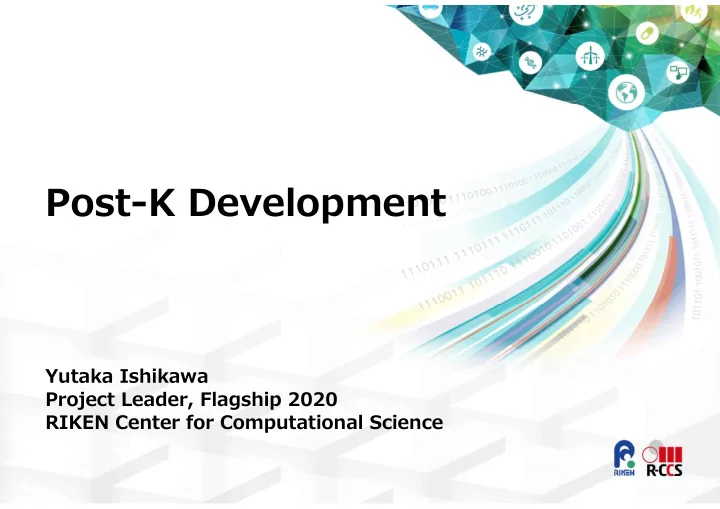

Post-K Development Yutaka Ishikawa Project Leader, Flagship 2020 RIKEN Center for Computational Science
Post-K A Post-K prototype machine was built in Summer 2018. Since then, Fujitsu has been testing and evaluating the machine. Ten racks of Post-K achieve almost the same performance of K computer (864 racks) X 10 = Post‐K K A64FX SPARC64 VIIIfx CPU Architecture (Armv8.2‐A SVE + Fujitsu Extension ) Cores 48 8 2.7+ TF 0.128 TF Peak DP performance Node Main Memory 32 GiB 16 GiB Peak Memory Bandwidth 1024 GB/s 64 GB/s Peak Network Performance 40.8 GB/s 20 GB/s Nodes 384 102 Rack Peak DP performance 1+ PF < 0.013PF Process Technology 7 nm FinFET 45 nm 3 20019/2/18 RIKEN Center for Computational Science
An Overview of Post-K Hardware 150k+ node Two types of nodes Compute Node and Compute & I/O Node connected by Fujitsu TofuD, 6D mesh/torus Interconnect 3-level hierarchical storage system 1 st Layer One of 16 compute nodes, called Compute & Storage I/O Node, has SSD about 1.6 TB Services - Cache for global file system - Temporary file systems - Local file system for compute node - Shared file system for a job 2 nd Layer Fujitsu FEFS: Lustre-based global file system 3 rd Layer Cloud storage services 20019/2/18 RIKEN Center for Computational Science 4
CPU A64FX Architecture Armv8.2‐A SVE (512 bit SIMD) Courtesy of FUJITSU LIMITED Core 48 cores for compute and 2/4 for OS activities DP: 2.7+ TF, SP: 5.4+ TF, HP: 10.8+ TF Cache L1 64 KiB, 4 way, 230+ GB/s(load), 115+ GB/s (store) CMG: 8 MiB, 16way Cache L2 Node: 3.6+ TB/s Core: 115+ GB/s (load), 57+ GB/s (store) Memory HBM2 32 GiB, 1024 GB/s CMG: CPU Memory Group Interconnect TofuD (28 Gbps x 2 lane x 10 port) NOC: Network On Chip I/O PCIe Gen3 x 16 lane Technology 7nm FinFET Performance Stream triad: 830+ GB/s Dgemm: 2.5+ TF (90+% efficiency) ref. Toshio Yoshida, “Fujitsu High Performance CPU for the Post-K Computer,” IEEE Hot Chips: A Symposium on High Performance Chips, San Jose, August 21, 2018. 20019/2/18 RIKEN Center for Computational Science 5
TofuD Interconnect 2 lanes x 10 ports TNR(Tofu Network Router) 40.8 GB/s (6.8 GB/s x 6) TNI0 TNI1 TNI2 TNI3 TNI4 TNI5 TNI: Tofu Network Interface (RDMA engine) • 6 RDMA Engines • Hardware barrier support • Network offloading capability 8B Put latency 0.49 – 0.54 usec 1MiB Put throughput 6.35 GB/s rf. Yuichiro Ajima, et al. , “ The Tofu Interconnect D,” IEEE Cluster 2018, 2018. 20019/2/18 RIKEN Center for Computational Science 6
Post-K Programming Environment Programing Languages and Script Languages provided by Fujitsu Compilers provided by Fujitsu E.g., Python+NumPy, SciPy Fortran2008 & Fortran2018 subset Communication Libraries C11 & GNU and Clang extensions MPI 3.1 & MPI4.0 subset C++14 & C++17 subset and GNU Fujitsu MPI (Based on Open MPI), Riken and Clang extensions MPI (Based on MPICH) OpenMP 4.5 & OpenMP 5.0 subset Low-level Communication Libraries Java uTofu (Fujitsu), LLC(RIKEN) GCC, LLVM, and Arm compiler will File I/O Libraries provided by RIKEN be also available pnetCDF, DTF, FTAR Parallel Programming Language & Math Libraries Domain Specific Library provided BLAS, LAPACK, ScaLAPACK, SSL II by RIKEN (Fujitsu) 。 XcalableMP EigenEXA, Batched BLAS (RIKEN) FDPS (Framework for Developing Programming Tools provided by Particle Simulator) Fujitsu Process/Thread Library provided Profiler, Debugger, GUI by RIKEN PiP (Process in Process) 20019/2/18 RIKEN Center for Computational Science 7
Other Software Other User-Land Batch Job System (Fujitsu) A Linux distribution Technical Computing Suite Open Source Management Tools Successor of Kʼs batch job system Spack/EasyBuild Operating System on Compute Nodes Linux (Fujitsu) McKernel, Light-weight Kernel (RIKEN) Executes the same binary of Linux McKernel McKernel without any recompilation Default Linux Default 4K 64K One of advantages is that McKernel .text 4K 64K 64K .data provides much larger page sizes 64K,2M,32M, 1G 2M, 512M 2M .bss 64K,2M,32M, 1G 2M, 512M 2M - Applications, accessing a huge memory Stack 64K,2M,32M, 1G 2M, 512M 2M area randomly, may benefit malloc 64K,2M,32M, 1G 2M, 512M 2M thread stack 64K,2M,32M, 1G 2M, 512M 2M User may select one of McKernel System V IPC 64K,2M,32M, 1G 2M, 512M 64K Shared configurations without rebooting POSIX 4K 64K 64K memory 64K,2M,32M, 1G 2M, 512M 64K XPMEM 20019/2/18 RIKEN Center for Computational Science 8
Concluding Remarks Post-K board, CMU, is displayed in the poster session room Poster presentations Programming Environments [50] Dynamic Multitasking in Upcoming XcalableMP 2.0 System Software [53] Prototype Implementation of MPICH and Data Transfer Framework for Post‐K Supercomputer [54] Operating System and Runtime Enhancements for the Post‐K Computer [55] Enhancing MPI‐IO with Topology‐Awareness at the K computer [56] Development of Scientific Numerical Libraries on post‐K computer Post-K Information is available https://postk‐web.r‐ccs.riken.jp/ 20019/2/18 RIKEN Center for Computational Science 9
Recommend
More recommend